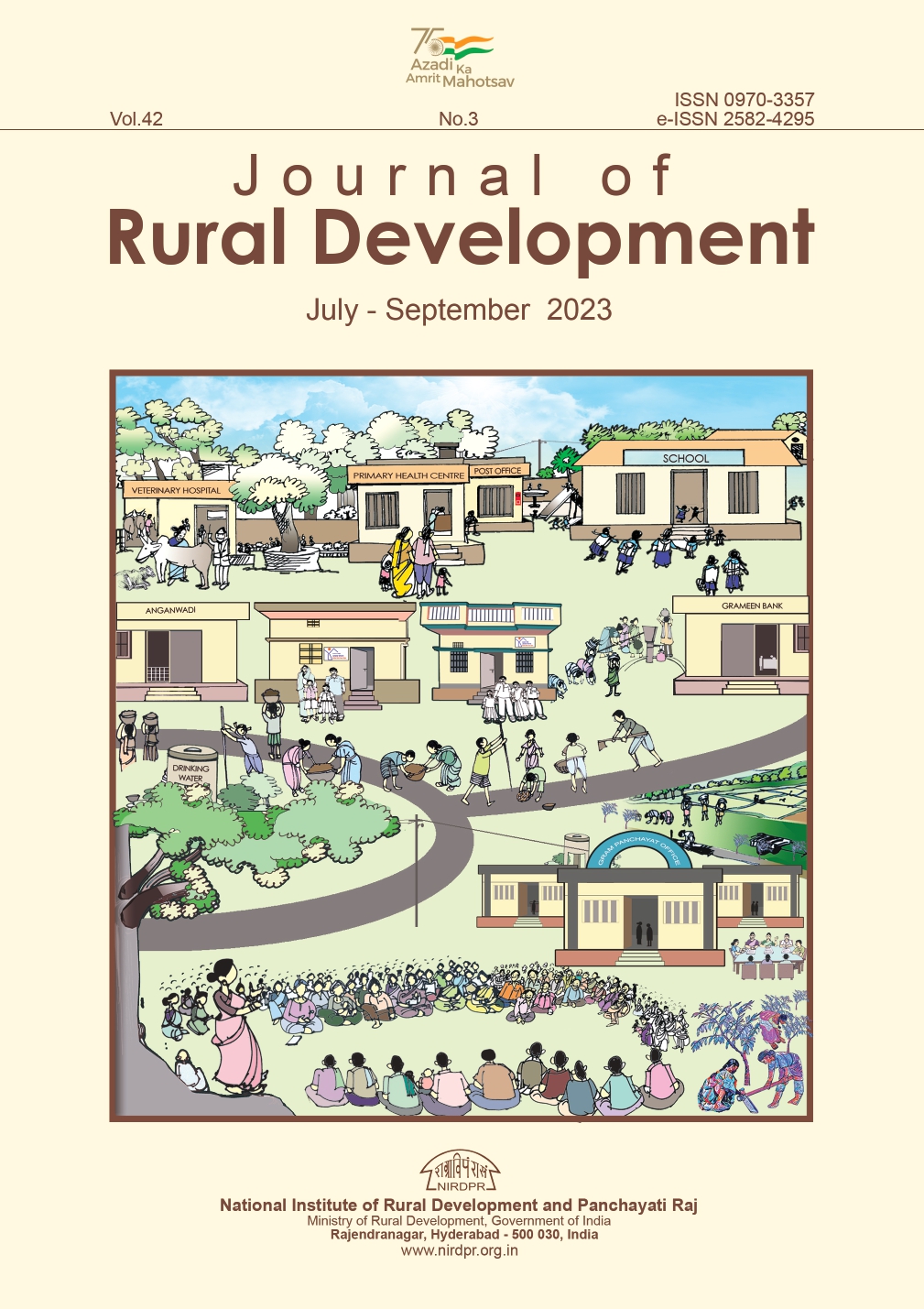Determinants of Marketing of Handloom Products Across Heterogeneous Weaving Business Units: A Study of Rural Assam
DOI:
https://doi.org/10.25175/jrd/2023/v42/i3/173261%20Keywords:
Rural Informal Business, Master Weaver, Independent Weaver, Household Business.Abstract
Success in marketing plays an important role in the growth and extension of rural non-farm informal sectors. The present study made an attempt to understand the marketing success among diverse groups of handloom weaving business units and factors determining the marketing of handloom products through the lens of weaving business units in rural Assam. Besides descriptive and inferential statistics, multiple linear regression method was applied for the analysis of data. The results of the study show that the success of marketing in terms of sales volume and revenue was significantly higher among the master weavers. Factors like years of schooling of handloom weaving entrepreneurs, business experience, working hours, storage capacity, advance payment requirement, number of handloom competitors in village, transportation cost, communication expense, and proximity to market significantly influenced the marketing across heterogeneous weaving business units in the study area. Steps towards the improvement of rural market infrastructure and road connectivity by taking a slew of suitable policies by Central and state governments may allow the rural handloom weavers to get better access to the market, which in turn, may assist in the promotion of sales.
Downloads
Downloads
Published
How to Cite
Issue
Section
References
Annapurna, M. (2006), Transitioning Markets: Transcending Consumption, Economic and Political Weekly, 41(31), 3388-3393.
Arnold, T.J., Palmatier, R.W., Grewal, D. & Sharma, A. (2009), Understanding Retail Managers’ Role in the Sales of Products and Services, Journal of Retailing, 85(2), 129-144.
Bhattacharya, R., & Sen, S. (2018), Pride and Prejudice: The Condition of handloom Weavers in West Bengal, CSE Working Paper 2018.
Chakravorty, R., Datta, P., & Goshe, J. (2010), Sericulture and Traditional Craft of Silk Weaving in Assam, Indian Journal of Traditional Knowledge, 9(2), 378-385.
Das, A. & Sutradhar, R. (2020), Handloom Weavers and Lockdown in Sualkuchi Cluster of Assam, Economic and Political Weekly, 55(39), 23-25.
Datta, D. B., & Sarkar, B. (2020). The Effectiveness of West Bengal State Khadi Mela as Organisational Marketing Tool, SEDME (Small Enterprises Development, Management & Extension Journal), 47(1), 64-77.
Dev, S.M., Galab, S., Reddy, P.P., & Vinayan, S. (2008). Economics of Handloom Weaving: A Field Study in Andra Pradesh, Economics and Political Weekly, 43(21), 43-51.
Goswami, K., Hazarika, B., & Handique, K. (2017). Determinants of Financial Risk Attitude among the Handloom Micro-Entrepreneurs in North East India, Asian Pacific Management Review, 22, 168-175.
Government of Assam (2020). “Statistical handbook of Assam, 2020”, Directorate of Economics and Statistics, Guwahati.
Hazarika, B. and Goswami, K. (2018). Micro-Entrepreneurship Development in Handloom Industry: An Empirical Analysis among the Tribal Women in Assam, International Journal of Rural Management, 14 (1), 22-38.
Kenton. W. (2020), available at: https://www.investopedia.com/terms/a/advance-payment.asp (accessed 8 January 2021)
Mahajan, V., Sharma, S. & Buzzell, R. D. (1993). Assessing the Impact of Competitive Entry on Market Expansion and Incumbent Sales, Journal of Marketing, 57(3), 39-52.
Mamonov, V., & Poluektov, V. (2021). “The Impact of Transport Costs on Sales in Supply Chains”, In: Murgul, V. and Pukhkal, V. (Eds) International Scientific Conference Energy Management of Municipal Facilities and Sustainable Energy Technologies EMMFT 2019. EMMFT 2019. Advances in Intelligent Systems and Computing, Vol 1258. Springer, Cham.
Ministry of Textile (2020). “Fourth All India Handloom Census Report, 2019-20”, Government of India, New Delhi.
Niranjana, S. (2004). Thinking with Handlooms Perspectives from Andhra Pradesh, Economic and Political Weekly, 39(6), 553-563.
Park, T., Paudel K. & Sene, S. (2018). Sales Impacts on Direct Marketing Choices: Treatment Effects with Multinomial Selectivity, European Review of Agricultural Economics, 45(3), 433-453.
Parker, S.C. (2018). “The Economics of Entrepreneurship”, Cambridge: Cambridge University Press.
Pham, T.T., Theuvsen, L., & Otter, V. (2019). Determinants of Smallholder Farmers’ Marketing Channel
Choice: Evidence from the Vietnamese Rice Sector, Asian Economic Journal,33(3), 281–300.
Raju, G. N. & Rao, K. V. (2014). A Study on the Socio-Economic Conditions of Handloom Weavers,
Journal of Rural Development, 33(3), 309-328.
Rao, K. R. M., & Manikyam, K. R. (2012). Marketing Strategies of Small Scale Retailers - A Study. SEDME
(Small Enterprises Development, Management & Extension Journal), 39(1), 43–57.
Schumpeter, J.A. (1911). “The Theory of Economic Development - An Inquiry into Profits, Capital, Credit,
Interest, and the Business Cycle”, Harvard University Press.
Singh, S., & Kumar, R. (2018). Handloom Entrepreneurship and Government Intervention: A Case Study of
Varanasi, Pacific Business Review International, 10 (9), 126-134.
Soe, W.P., Moritaka, M., & Fukuda, S. (2015). An Analysis of the Factors Influencing Marketing Channel Choice by Paddy Rice Farmers in Myanmar, Journal of the Faculty of Agriculture, Kyushu University, 60 (2), 535–42.
Solanki, S.S. (2008). Sustainability of Rural Artisans, Economic and Political Weekly, 43(19), 24-27. Srinivasulu, K. (1994). Handloom Weavers' Struggle for Survival, Economic and Political Weekly, 29(36),
-2333.
Strategic Investment Research Unit (2021). “Weaving India’s Future- Investment in the Handloom Sector”, Retrieved on 10th September 2023 from Weaving India’s Future – Investment in the Handloom Sector (investindia.gov.in)
Sujan, H., Weitz, B.A. & Kumar, N. (1994). Learning Orientation, Working Smart, and Effective Selling, Journal of Marketing, 58(3), 39-52.
Sulistyo, H., & Siyamtinah. (2016). Innovation Capability of SMEs through Entrepreneurship, Marketing Capability, Relational Capital and Empowerment, Asia Pacific Management Review, 21(4), 196-203.
Zhang, B., Fu, Z., Wang, J., Tang, X., Zhao, Y. & L. Zhang, Y. (2017). Effect of Householder Characteristics, Production, Sales and Safety Awareness on Farmers’ Choice of Vegetable Marketing Channels in Beijing, China, British Food Journal,119(6), 1216–31.






